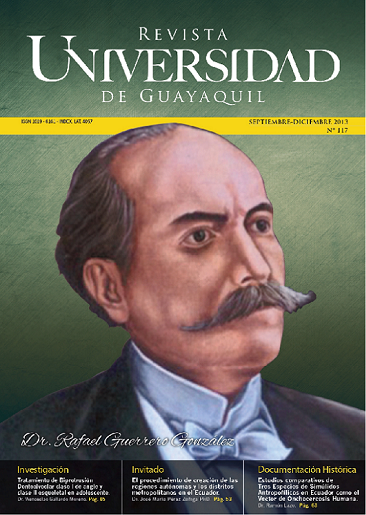Nutrition Diagnosis of schoolchildren in southern Guayaquil
DOI:
https://doi.org/10.53591/rug.v117i3.869Keywords:
Growth Trends, Eutrophic, Malnutrition, Chronic MalnutritionAbstract
The study aims to determine the nutritional status of preschool and school population, from the area of Guasmo and Isla Trinidad at the City Guayaquil - Guayas Province, Ecuador and profile the nutritional status. Previous studies suggest that in Ecuador there is a state of chronic malnutrition in school-age population, which corresponds to altered patterns of growth and development of children. Using standardized methodology, through anthropometric measurements or somatometric: weight , length and head circumference for nutritional assessment of school-age children, there was a developmental trend that would seem to support the thesis of chronic malnutrition . However, after closer look at the results we can suggest an alternative to the interpretation of the results, considering that the growth patterns, conditioned by population genetic determinants could differ from standardized growth patterns suggested by the World Health Organization. The results suggest that the second alternative is true so it would merit further studies to corroborate the findings
References
“Indicadores Básicos de Salud Ecuador 2010,” p. 19, 2010.
S. WIJAYA, Determinants of Chronic Malnutrition among Ecuadorian Children aged 0-23 months in Cuenca and Nabon Cantons. 2011.
C. Larrea and W. Freire, “Social inequality and child malnutrition in four Andean countries.,” Rev. Panam. Salud Publica, vol. 11, no. 5–6, pp. 356–64, 2002
León, C. C. (2010). Seguridad alimentaria en el Ecuador desde un enfoque de acceso a alimentos. Retrieved from http://www.flacsoandes.org/dspace/handle/10469/3097
M. GORDILLO A. Tratado Teórico Practico para evaluar al niño Desnutrido “LA DESNUTRICION EN EL ECUADOR” Universidad de Guayaquil-Escuela de Graduados –Facultad de Ciencias Médicas – Segunda Edición 2004.
Gutierrez-jimenez, J., Torres-sanchez, M. G. C., Fajardo-martinez, L. P., Schlie-, M. A., Luna-cazares, L. M., Gonzalez-esquinca, A. R., … Vidal, E. (2013). Original Article Malnutrition and the presence of intestinal parasites in children from the poorest municipalities of Mexico. jinfect dev ctries; jidc. doi:10.3855/ jidc.2990
Banco Mundial. Insuficiencia Nutricional en Ecuador, Quito; 2007.
Martínez, R., & Fernández, A. (2009). El costo del hambre: impacto social y económico de la desnutrición infantil en el Estado Plurinacional de Bolivia, el Ecuador, Paraguay y el Perú. Retrieved from http://dide.minedu.gob.pe/xmlui/handle/123456789/591
Organization, W. H., & UNICEF. (2009). WHO child growth standards and the identification of severe acute malnutrition in infants and children. Retrieved from http://scholar.google.com/scholar?hl=en&btnG=Search&q=intitle:WHO+Child+growth+standards+and+the+identification+of+severe+acute+malnutri tion+in+infants+and+chidren#5
Onis, M. de, & Onyango, A. (2008). WHO child growth standards. Lancet. Retrieved from http:// cdrwww.who.int/entity/childgrowth/publications/ca_symposium_comparison/en/
So, H. K., Nelson, E. a S., Sung, R. Y. T., & Ng, P. C. (2011). Implications of using World Health Organization growth reference (2007) for identifying growth problems in Hong Kong children aged 6 to 18 years. Hong Kong medical journal = Xianggang yi xue za zhi / Hong Kong Academy of Medicine, 17(3), 174–9. Retrieved from http://www.ncbi.nlm.nih.gov/pubmed/21636863
Katuli, S., Natto, Z. S., Beeson, L., & Cordero-MacIntyre, Z. R. (2013). Nutritional status of highland and lowland children in Ecuador. Journal of tropical pediatrics, 59(1), 3–9. doi:10.1093/tropej/ fms032
Published
How to Cite
Issue
Section
License

This work is licensed under a Creative Commons Attribution-NonCommercial-NoDerivatives 4.0 International License.

This work is licensed under a Creative Commons Attribution-NonCommercial-NoDerivatives 4.0. International License.
You are free to:
- Share — copy and redistribute the material in any medium or format
- The licensor cannot revoke these freedoms as long as you follow the license terms.
Under the following terms:
- Attribution — You must give appropriate credit , provide a link to the license, and indicate if changes were made . You may do so in any reasonable manner, but not in any way that suggests the licensor endorses you or your use.
- NonCommercial — You may not use the material for commercial purposes .
- NoDerivatives — If you remix, transform, or build upon the material, you may not distribute the modified material.
- No additional restrictions — You may not apply legal terms or technological measures that legally restrict others from doing anything the license permits.































